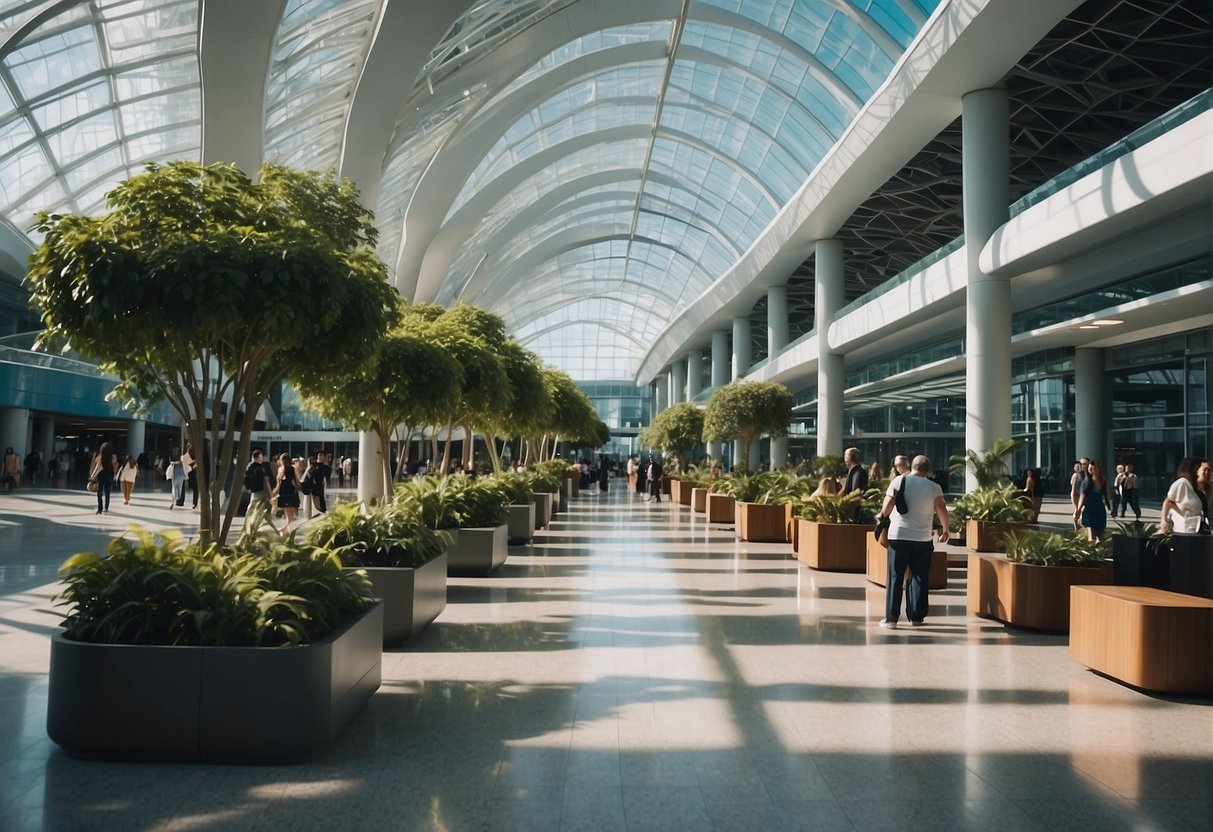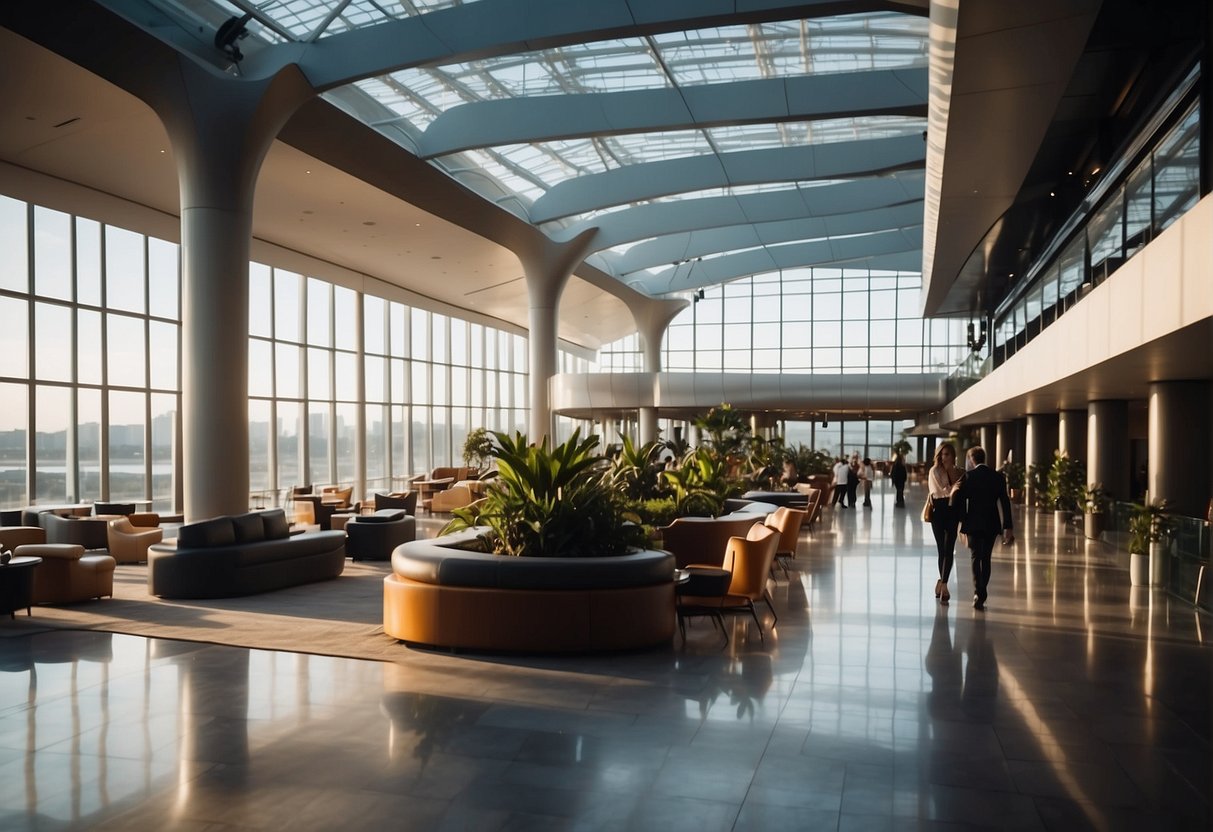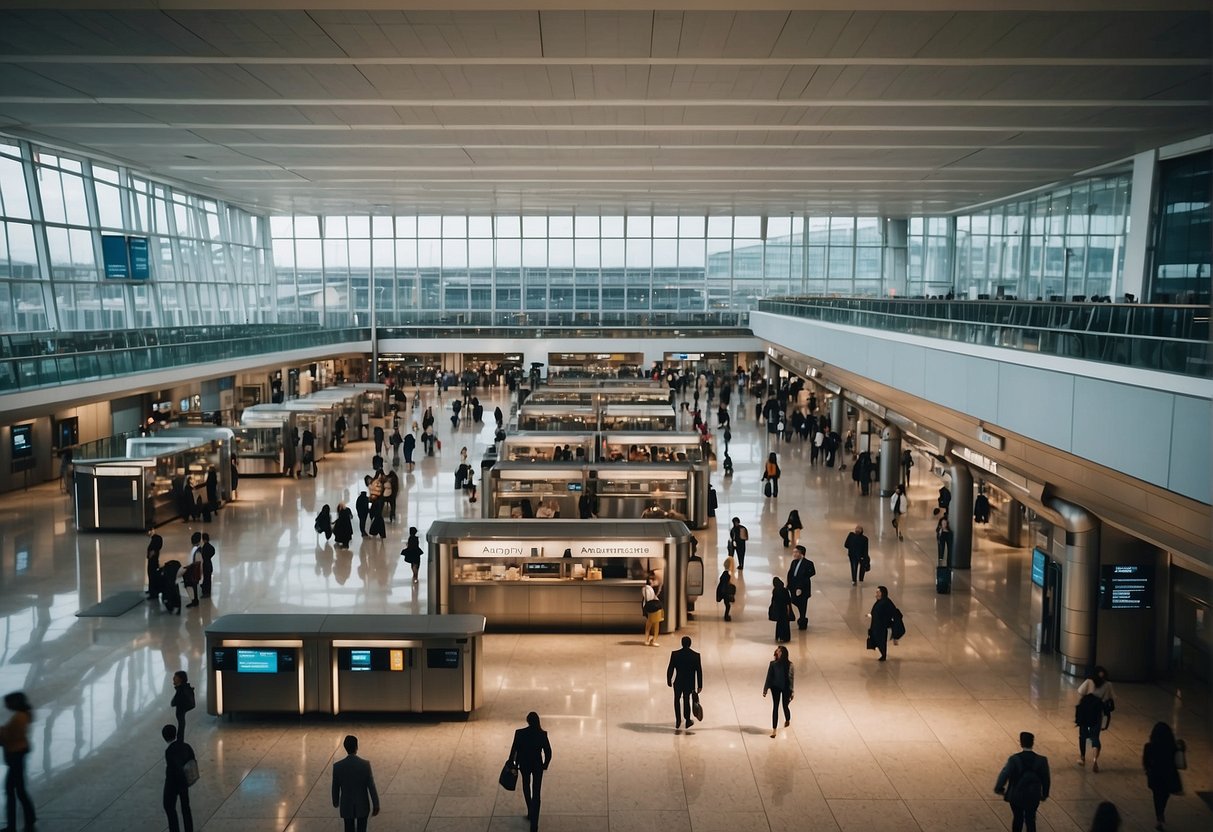Evaluating the world’s airports is a complex endeavor, considering the vast array of factors that contribute to a traveler’s experience. From the ease of navigation through terminals to the quality of customer service, the amenities available, and even the aesthetic appeal, every facet plays a part in forming the reputations of these international travel hubs. The most esteemed airports set themselves apart by excelling across all these categories, providing seamless, efficient, and enjoyable travel experiences.

Airports serve as critical gateways connecting diverse destinations, cultures, and economies. The best among them facilitate this connectivity while also emphasizing security and technological innovation. They are not just transit points but destinations in their own right, offering a glimpse into the future of travel. Advanced airports have transformed passenger experiences through their emphasis on efficiency and inclusivity, integrating cutting-edge technology while providing a broad spectrum of services for both leisure and business travelers.
Key Takeaways
- Top airports worldwide excel in efficiency, aesthetics, and traveler services.
- Security and advanced technology are central to the best airports’ operations.
- Leading airports act as critical hubs for both leisure and business connectivity.
Evolution of Air Travel
Air travel has undergone a dramatic transformation over the decades. Initially a luxury for the few, it has evolved into a global phenomenon accessible to a wide array of passengers. Innovations in aviation technology and airport facilities have continually shaped travel experiences, making them safer, faster, and more comfortable.
The most significant change in recent history was catalyzed by the pandemic. It compelled the aviation industry to adapt quickly, restructuring processes to prioritize health and safety. Mandatory face masks, enhanced cleaning protocols, and adjustments for social distancing became the new norm.
As the industry recovers, a focus on passengers has led to advancements in airport design and technology. Terminals are becoming more intuitive and user-friendly, with digital signage, improved wayfinding, and streamlined security processes. The integration of technologies such as biometrics for identity verification has the potential to further personalize and expedite the travel experience.
Airports themselves are anticipating an increase in passenger traffic. Forecasts suggest a steady growth in the number of people flying, with projections indicating over 19 billion passengers will pass through airports annually by 2040.
Despite challenges, the air travel sector continues to thrive and adapt, ensuring that it remains an essential and efficient part of global transportation and connectivity. Looking ahead, the evolution of air travel promises to embrace further innovation in sustainability and passenger service, shaping the future of air transit in ways yet to be fully realized.
Criteria for Ranking Airports

When ranking the world’s best airports, specific criteria are taken into account. These criteria revolve around award systems, detailed customer satisfaction surveys, and the comprehensive evaluation of facility and service quality.
Award Systems
Skytrax is a prominent entity in the aviation industry known for its annual awards, establishing a quality benchmark for the world’s airports. It bases its rankings on in-depth research and a variety of performance metrics. Airports strive for these prestigious accolades as they reflect global recognition in the aviation sector.
Customer Satisfaction Surveys
Customer satisfaction surveys play a pivotal role in airport rankings, drawing from passenger feedback on a wide range of services and experiences. Global customer satisfaction surveys assess factors such as check-in efficiency, seating availability, and cleanliness. The more comprehensive the survey, the more accurate the reflection of an airport’s performance from a customer’s perspective.
Facility and Service Quality
The quality of both facilities and services provided is scrutinized closely. Airports are evaluated on the availability of amenities, the efficiency of security procedures, and overall airport ambiance. The quality of an airport’s service and facility can significantly impact its ranking, highlighting the importance of a high standard for these elements in maintaining a favorable reputation among travelers.
Key Features of Top Airports
The world’s best airports stand out for their exceptional attention to passenger comfort, extensive range of amenities, and commitment to providing a memorable travel experience through thoughtful design.
Comfort and Design
At the forefront of airport innovation, Singapore Changi Airport sets a high standard for comfortable transit with its awe-inspiring indoor waterfall and nature-themed design. Beyond aesthetic appeal, the world’s top airports ensure seating options cater to varying needs, often featuring rest zones outfitted with recliners or full-body loungers. Design elements are strategically chosen to mitigate travel stress, with natural light, green spaces, and intuitive layouts to ease passenger movement.
Dining and Shopping
An array of culinary offerings is a hallmark of top-tier airports, providing anything from gourmet local cuisine to international fare. The dining experience is carefully curated to cater to the tastes of a global audience, while also spotlighting regional flavors. Similarly, shopping options range from luxury retail outlets to local souvenir shops, offering passengers a diverse shopping experience. For instance, duty-free shopping at airports like Hamad International Airport provides a chance for travelers to indulge in high-end brands and exclusive airport-only items.
Entertainment and Relaxation
Leading airports deliver diverse entertainment and relaxation options tailored for layovers of any length. This includes movie theaters showcasing the latest blockbusters, interactive art installations, and cultural exhibits. An oasis within the airport, spas provide a chance for rejuvenation before the next leg of a journey. In terms of relaxation, dedicated quiet zones and lounges offer serene environments where passengers can unwind. Amenities such as these underscore a commitment to enhancing the travel experience beyond merely spending time waiting for a flight.
Security and Safety
When considering the best airports in the world, a critical component is the security and safety measures they offer. Airports are continually improving their processes for check-in and security processing as well as health and sanitation protocols to ensure that passengers have a safe and efficient experience.
Check-In and Security Processing
Efficient and thorough security processing is essential for a best-ranking airport. A standout in this category is Zurich Airport, which excels in offering a seamless security experience for travelers. Checked baggage and personal screenings are quick and meticulous, ensuring passenger safety. For detailed information on international security measures like those TSA requires, travelers will find relevant details on travel guidelines, which provide in-depth understanding of what to expect during airport security processes.
- Security Points:
- Use of advanced technology for quick scans
- Highly trained personnel
Health and Sanitation
In recent years, health and sanitation have become a top priority for airports. From regular cleaning of public spaces to mandatory COVID-19 tests for international travel, best airports have adapted rapidly to protect health and ensure safety. Implementing state-of-the-art cleanliness protocols has been a key factor in reassuring passengers.
- Cleanliness Standards:
- Frequent disinfection of high-contact areas
- Availability of hand sanitizer stations throughout terminals
Regular deep cleaning is now part of the standard operating procedures, contributing to overall airport hygiene. Such measures not only provide safety but also instill confidence among travelers, making their journey more pleasant.
Notable Airports Worldwide
In the realm of aviation, certain airports distinguish themselves through exceptional service, innovative facilities, and seamless operations. From Asia’s bustling hubs to North America’s gateways, these airports set the benchmark for global travel.
Asia
Tokyo’s Haneda Airport is a paragon of efficiency and cleanliness, often praised for its exceptional service. Singapore’s Changi Airport is renowned for its ultramodern amenities, including butterfly and cactus gardens. Seoul’s Incheon International Airport is celebrated for its rapid customs processing and a plethora of entertainment options.
- Japan: Home to Haneda Airport, lauded for its punctuality and domestic connectivity.
- Singapore: Singapore Changi Airport astonishes with its unique attractions and shopper’s paradise.
- South Korea: Incheon International Airport is noted for its advanced technology and cultural showcases.
Europe
Zurich Airport in Switzerland impresses with its cleanliness and swift transit times. France’s Paris Charles de Gaulle Airport is the front-runner in handling international traffic with panache. Germany’s Munich Airport is acclaimed for its architectural elegance and traveller-friendly atmosphere.
- Switzerland: Zurich Airport stands out with efficient services and a commitment to hospitality.
- France: Famed for its sophisticated art installations, Paris Charles de Gaulle Airport charms global travelers.
- Germany: Munich Airport blends Bavarian culture with state-of-the-art facilities.
Middle East
The illustrious Dubai International Airport serves as a global nexus, known for its vast duty-free shopping areas. Istanbul Airport dazzles with its grandiose scale and strategic location between continents. Qatar’s Hamad International Airport exudes luxury and ensures a memorable gateway to the region.
- United Arab Emirates: Dubai International Airport stands as a crossroads of international commerce and travel.
- Turkey: Istanbul Airport connects the East and West with modern splendor and vast connectivity.
- Qatar: The majestic Hamad International Airport is recognized for its sleek design and premium lounges.
North America
In North America, airports are seeing revamped efforts to improve the travel experience. Upgraded terminals and enhanced services are becoming a common theme across the continent’s airports, aiming to match their global counterparts in passenger satisfaction and efficiency.
- United States: North America’s airports strive for higher standards with ongoing transformations.
Technological Advancements
Airports globally are harnessing the power of cutting-edge technologies to enhance traveler experience and operational efficiency.
Wi-Fi: Most top-tier airports now offer complimentary high-speed Wi-Fi, ensuring passengers stay connected from departure to arrival gates.
Security Processing: Enhanced security features are now commonplace, with biometric systems and facial recognition both speeding up identification processes and strengthening security. Airports are also implementing advanced scanners, reducing the need for manual checks and minimizing delays.
Terminal Layout: Smart design combined with technology optimizes passenger flow. Interactive kiosks assist with navigation, while digital displays provide real-time updates on flights and airport services.
| Innovation | Description |
|---|---|
| Biometric Verification | Utilized for quick identity checks, improving both efficiency and safety. |
| E-Gates | Self-service barriers expedite the boarding process and customs clearance. |
| Automated Bag Drop | Passengers can independently check-in luggage, shortening queue times. |
With ongoing advancements, they ensure these technologies not just meet current traveler expectations, but anticipate future needs.
Accessibility and Connectivity
When assessing the world’s leading airports, access is a critical metric. Major airports offer extensive transport options, including trains, buses, taxis, and shared rides, simplifying the journey for travelers. For instance, airports that are well-connected to urban centers attract more passengers due to their ease of access and range of transportation services available.
The number of destinations an airport connects to directly impacts its standing in global rankings. Airports serving as hubs for major airlines typically provide a vast network of destinations, offering both passengers and cargo direct access to international and domestic locations. Such airports facilitate a seamless travel checklist for international travel as travelers can reach numerous cities across continents with minimal layovers.
| Key Attribute | Importance |
|---|---|
| Transport Links | Critical for convenient access to and from the airport |
| Destinations | Defines the airport’s connectivity scope |
Moreover, the quality and frequency of intermodal connections are important for passengers catching connecting flights or needing swift transit to nearby cities. Effective signage, information desks, and easy-to-navigate terminals are also part of the accessibility framework, allowing passengers, especially international travelers, to move through the airport comfortably.
In summary, airports with robust accessibility and connectivity features not only bolster their appeal to travelers but also contribute significantly to their recognition as some of the best in the world.
Leisure and Business Travel Facilities
When it comes to leisure travel, many of the world’s best airports offer an array of amenities that cater to relaxation and enjoyment. Lounges have evolved, now providing not just comfortable seating and complimentary snacks, but also spa services, private nap rooms, and sophisticated cocktail bars. For families, play areas and themed entertainment spaces allow for a fun distraction before flights.
Business travelers prioritize efficiency, with airports often featuring dedicated check-in counters, fast-track security clearance, and business centers equipped with charging stations and high-speed Wi-Fi. For meetings, conference rooms with audio-visual facilities are a standard in major airports. Additionally, hotels integrated within airports or situated nearby offer the convenience of booking flexible Marriott Bonvoy Homes and Villas for longer layovers or quick overnight stays between flights.
| Traveler Type | Facility | Description |
|---|---|---|
| Leisure | Spa Services | Massages, facials, and relaxation zones. |
| Business | Fast-Track Security | Quicker security checks to save time. |
| Leisure | Entertainment Spaces | Areas for entertainment, including cinemas and gardens. |
| Business | Conference Rooms | Private spaces for meetings, with necessary tech support. |
In regions dotted with islands, such as Southeast Asia or the Caribbean, airports act as gateways to paradise, offering tours and tailored experiences directly bookable at kiosks within the terminals. This seamless connection between airport and island escapes is a massive boon for leisure travelers eager to maximize their holiday time.
Traveler-Centric Services and Amenities

Modern airports are increasingly focusing on the needs of travelers, providing a range of services and amenities that cater to various passenger requirements. For families, dedicated play areas and child-friendly facilities ensure a stress-free travel experience. Quiet rooms and changing facilities add to the comfort for both parents and children.
Lovers and couples might find solace in more intimate amenities such as couple’s lounges and designated quiet zones that offer privacy and relaxation. Complimentary Wi-Fi enables travelers to stay connected, making the exchange of sweet nothings or important updates effortless, with options available for international travel phone plans to connect beyond the airport.
When it comes to accessories, many airports feature a variety of retail stores. From designer outlets to duty-free shops, passengers can browse an extensive collection of goods ranging from luxury items to travel essentials.
In terms of service, the presence of multilingual staff and information kiosks help navigate the often complex airport layouts. Additionally, for peace of mind, travelers can secure their trips with worldwide travel insurance, ensuring coverage from unforeseen events.
Accessibility amenities, such as priority boarding for passengers with disabilities, reflect the inclusive nature of worldwide top-ranked airports. Meanwhile, those traveling for business might appreciate facilities like expedited security lanes and on-the-go meeting rooms.
Travelers with specific health insurance, such as Kaiser Permanente, can find airports equipped with medical clinics that acknowledge diverse international coverages.
Luxuries like shower rooms, sleeping pods, and massage services address the fatigue associated with long-haul flights. High-end dining experiences and fast-food outlets cater to a wide range of palates and time constraints, underpinning the airport’s commitment to offering traveler-centric conveniences.
Frequently Asked Questions

In discerning which airports are the best, travelers and industry experts consider a range of factors, from customer satisfaction to facilities.
What are the criteria for an airport to be named the best in the world?
Criteria include efficiency, customer service, cleanliness, and the availability of amenities. Airports must demonstrate exemplary service and innovation to be considered the best.
How do traveler experiences affect airport rankings globally?
Traveler feedback and satisfaction surveys play a critical role in determining airport rankings. They reflect the quality of the airport’s services, amenities, and overall travel experience.
Which airport has received the highest customer satisfaction ratings?
Singapore Changi Airport consistently receives high customer satisfaction ratings, praised for its exceptional services and unique attractions like the indoor waterfall.
Which facilities contribute to an airport being classified as luxurious?
Luxurious airports typically offer high-end shopping, gourmet dining, private lounges, spa services, and sometimes even in-terminal hotels.
What advancements are modern airports making to improve the traveler experience?
Airports are incorporating advanced technology, streamlined security, and better crowd management to enhance the traveler experience, aiming for a smooth and enjoyable journey.
How often are global airport rankings updated and what impact does it have on travel choices?
Airport rankings are typically updated annually. These rankings inform travelers and can influence their choice of airlines, routes, and layover airports.
Leave a Reply